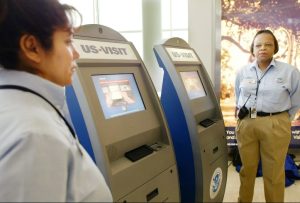A look at the tiny chip embedded in many passports and what information it holds.
While they still look like passports of old, a biometric passport or e-Passport contains a microchip in the cover with personal information stored on it. This allows border control agents to match and confirm the person’s identity by presenting the passport with the information loaded on it.
To ensure that the passport is valid, the chip must be authenticated by public key infrastructure (PKI), making it a complicated and expensive thing to forge. This means that if all security protocol is followed correctly, it is easy to detect a forged passport. PKI is a set of regulations, procedures, and policies needed to create and manage digital certificates.

Country’s that have issued biometric passports. Image: Wikipedia Commons
Biometric identity data is stored on the chip
The Radio Frequency Identification (RFID) chip in your passport includes all your biometric data, such as a face scan to match facial recognition technology, fingerprints, and an iris scan. Malaysia was the first country to issue biometric passports in 1998, and by 2019 around 160 countries were issuing biometric passports to their citizens.
All biometric passports issued by the United States of America and countries that are a part of the USA visa waiver program have security features built into them to prevent the unauthorized reading of any data stored on the chip. Security features in biometric passports allow for the following:
- Basic Access Control (BAC): This ensures that the passport is genuine and matches the person’s identity presenting it.
- Extended Access Control (EAC): This protects the holder’s privacy, including fingerprints that may be stored on the biometric chip.
One of the significant advantages of an e-passport is security, as someone can’t steal your identity. While the chips on e-passports can be detected from several feet away, the data on the chip can only be accessed if the passport is within four inches of the scanner.
The convenience of an e-passport
Having an e-passport means that in many instances, such as returning to your home country, there is no need to wait in a long line. Instead of waiting for a border patrol agent, you just hold your passport over a scanner. The machine then matches your data with facial technology while recording that you are back in the country.

Some people are opposed to biometric passports
While the security benefits and convenience of biometric passports are easy to see, many opponents question how they affect civil liberties. They point out that one of the main problems of biometric passports is that the data on the chip can be transferred wirelessly using RFID technology. They say that the information stored on the chip is not encrypted and could easily be used by criminals.
What do if you lose your passport?
Despite the new technology and features, biometric passports have nothing built into them that allows you to find your passports if it is lost or stolen. When traveling, have all your information stored on your phone, including a photo of your passport information page.
If you have lost your passport or think that it has been stolen, the first thing you need to do is report it to the local police. Ask them to give you an incidence report as you may need this to show your embassy or consulate before obtaining a new passport or temporary travel document. The next step is to report the loss of your passports to your embassy or consulate with the following information:
- Full name
- Date and place of birth
- How you have lost your visa (theft, loss, etc.)
- Copy of your passport, if you have one, together with a copy of the police report
Your embassy or consulate will then tell you what steps you need to take next.
credit: simpleflying.com

